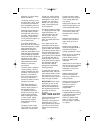19
This will prevent egg
yolks from getting into
the saved egg white.
4. For good results, all
tools must be absolutely
clean, dry and free from
any trace of grease or oil.
5. Add a pinch of salt or
cream of tartar through
the small feed tube when
the eggs begin to foam.
6. If the recipe calls for
sugar, add it gradually,
about 2 tablespoons
(30ml) at a time. This too
can be added through
the small feed tube as
the egg whites begin to
form soft peaks. Once
the egg whites start to
stiffen, stop the machine
and use a spatula to
brush the sugar off the
top of the power unit and
from the sides of the
work bowl.
7. Rub a pinch of whites
between your fingers. If it
feels grainy, the sugar is
not completely dissolved
and the whites should be
beaten a little longer.
Folding Beaten Egg
Whites into Base Mixture:
1. Once the egg whites are
beaten, fold them into
the base mixture as soon
as possible. They deflate
as they stand.
2. The metal blade of your
food process will fold the
egg whites into the base
efficiently. Add a big
spoonful of whites and
pulse to combine. This
lightens the base. Add
the remaining whites on
top of the base mixture
and combine with short
pulses until the egg
whites are just mixed
with the base. It is better
to have some whites
showing than to over
mix.
3. If folding by hand, draw
a spatula from the cen-
tre of the bowl toward
you, moving it down in
the centre and scooping
it up to the rim. This
folds the egg whites into
the heavier base mix-
ture. Rotate the bowl a
quarter turn clockwise
and repeat the motion
with the spatula.
Continue rotating the
bowl and folding with
the spatula until all the
whites are incorporated.
Whichever way you fold in
the egg whites, use a light
touch. It is important to
incorporate the whites
thoroughly while working
them as little as possible,
to avoid deflating them.
Freezing Leftover
Egg Yolks:
When you make recipes
that use a lot of egg whites,
you always face the ques-
tions of what to do with the
yolks. They freeze very
well if you add a little
sugar. Add 1 tablespoon
(15ml) of sugar for each
egg yolk, beat lightly to
combine,and freeze the
mixture in airtight contain-
ers.
The whisk attachment may
be used to prepare a pack-
aged cake mix. For best
results, ingredients should
be at room temperature;
butter, if used, should be
softened, not melted. Eggs
can safely be warmed by
placing them in a bowl or
warm tap water for 5 to 10
minutes.
Add the dry mix to the work
bowl. Whisk for 20 seconds
to aerate and remove any
lumps. For cake mixes that
use oil, add the oil and eggs.
Whisk for 15 seconds while
adding the water through
the small feed tube. Scrape
the bottom and sides of the
work bowl. Then whisk for
2 minutes. For cake mixes
that use butter, cut the
softened (not melted) butter
into tablespoon size pieces.
Add the butter and eggs to
the work bowl. Whisk for
15 seconds while adding
the water through the small
feed tube. Scrape the bot-
tom and sides of the work
bowl. Whisk for the time
recommended on the
package instructions for
using a power mixer.
CLEANING AND
STORAGE
Keep your food processor
ready to use on a kitchen
counter. When not in use,
leave it unplugged. Don’t
leave it with the pusher
assembly in the locked
position; this could damage
the on-off mechanism.
Store the blades and discs
as you would sharp knives,
out of the reach of children.
The disc and blade holders
are optional accessories
which offer safe and
convenient storage.
All parts except the housing
base are dishwasher safe,
and we recommend wash-
ing them in the dishwasher
on the top rack. Due to
intense water heat washing
the work bowl, cover and
accessories on the bottom
rack may cause damage
over time. Insert the work
bowl upside down.
Remember to unload
the dishwasher carefully
03CC18070 MP-14C IB 6/17/03 1:55 PM Page 20


















